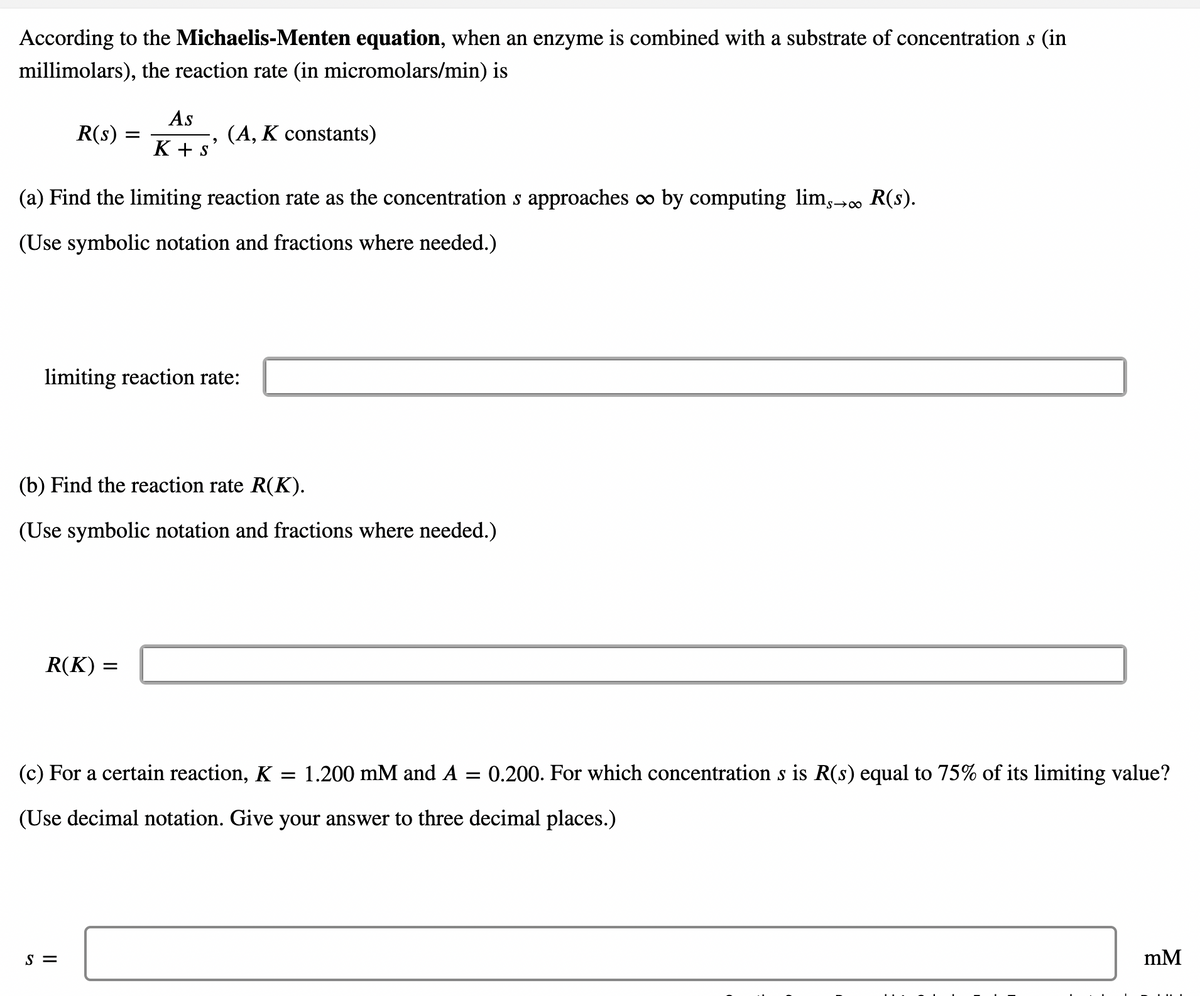According to the Michaelis-Menten equation, when an enzyme is combined with a substrate of concentration s (in millimolars), the reaction rate (in micromolars/min) is As R(s) (A, K constants) K + s (a) Find the limiting reaction rate as the concentration s approaches co by computing lim,° R(s). (Use symbolic notation and fractions where needed.) limiting reaction rate: (b) Find the reaction rate R(K). (Use symbolic notation and fractions where needed.) R(K) = (c) For a certain reaction, K = 1.200 mM and A = 0.200. For which concentration s is R(s) equal to 75% of its limiting value? (Use decimal notation. Give your answer to three decimal places.) S = mM
According to the Michaelis-Menten equation, when an enzyme is combined with a substrate of concentration s (in millimolars), the reaction rate (in micromolars/min) is As R(s) (A, K constants) K + s (a) Find the limiting reaction rate as the concentration s approaches co by computing lim,° R(s). (Use symbolic notation and fractions where needed.) limiting reaction rate: (b) Find the reaction rate R(K). (Use symbolic notation and fractions where needed.) R(K) = (c) For a certain reaction, K = 1.200 mM and A = 0.200. For which concentration s is R(s) equal to 75% of its limiting value? (Use decimal notation. Give your answer to three decimal places.) S = mM
Chemistry: The Molecular Science
5th Edition
ISBN:9781285199047
Author:John W. Moore, Conrad L. Stanitski
Publisher:John W. Moore, Conrad L. Stanitski
Chapter11: Chemical Kinetics: Rates Of Reactions
Section: Chapter Questions
Problem 81QRT
Related questions
Question

Transcribed Image Text:According to the Michaelis-Menten equation, when an enzyme is combined with a substrate of concentration s (in
millimolars), the reaction rate (in micromolars/min) is
As
R(s)
(A, K constants)
K + s'
(a) Find the limiting reaction rate as the concentration s approaches ∞ by computing lim,→. R(s).
(Use symbolic notation and fractions where needed.)
limiting reaction rate:
(b) Find the reaction rate R(K).
(Use symbolic notation and fractions where needed.)
R(K) =
(c) For a certain reaction, K = 1.200 mM and A
0.200. For which concentration s is R(s) equal to 75% of its limiting value?
(Use decimal notation. Give your answer to three decimal places.)
S =
mM
Expert Solution
This question has been solved!
Explore an expertly crafted, step-by-step solution for a thorough understanding of key concepts.
This is a popular solution!
Trending now
This is a popular solution!
Step by step
Solved in 2 steps with 2 images

Recommended textbooks for you

Chemistry: The Molecular Science
Chemistry
ISBN:
9781285199047
Author:
John W. Moore, Conrad L. Stanitski
Publisher:
Cengage Learning

Chemistry by OpenStax (2015-05-04)
Chemistry
ISBN:
9781938168390
Author:
Klaus Theopold, Richard H Langley, Paul Flowers, William R. Robinson, Mark Blaser
Publisher:
OpenStax

Principles of Modern Chemistry
Chemistry
ISBN:
9781305079113
Author:
David W. Oxtoby, H. Pat Gillis, Laurie J. Butler
Publisher:
Cengage Learning

Chemistry: The Molecular Science
Chemistry
ISBN:
9781285199047
Author:
John W. Moore, Conrad L. Stanitski
Publisher:
Cengage Learning

Chemistry by OpenStax (2015-05-04)
Chemistry
ISBN:
9781938168390
Author:
Klaus Theopold, Richard H Langley, Paul Flowers, William R. Robinson, Mark Blaser
Publisher:
OpenStax

Principles of Modern Chemistry
Chemistry
ISBN:
9781305079113
Author:
David W. Oxtoby, H. Pat Gillis, Laurie J. Butler
Publisher:
Cengage Learning

Chemistry for Engineering Students
Chemistry
ISBN:
9781337398909
Author:
Lawrence S. Brown, Tom Holme
Publisher:
Cengage Learning

Chemistry
Chemistry
ISBN:
9781305957404
Author:
Steven S. Zumdahl, Susan A. Zumdahl, Donald J. DeCoste
Publisher:
Cengage Learning

Chemistry: An Atoms First Approach
Chemistry
ISBN:
9781305079243
Author:
Steven S. Zumdahl, Susan A. Zumdahl
Publisher:
Cengage Learning